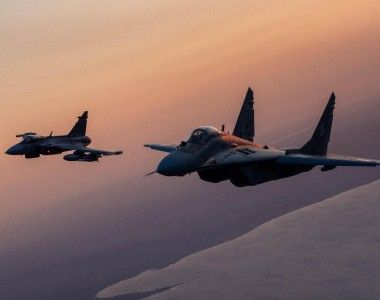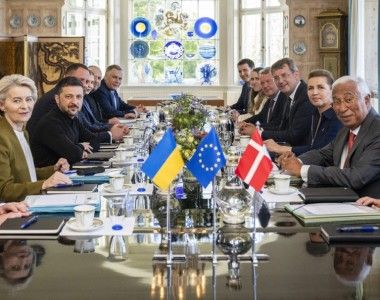Russia Losing 22 Battalion Tactical Groups: Is BTG a myth, or is it truly effective in combat? [ANALYSIS]

Over the last two weeks of the war in Ukraine, we have heard many reports on the losses that the Russians have suffered from, which caused the Russian offensive to stop, according to the Ukrainian MoD. One should note that information warfare is intense in this domain. This does not make it easy to deduce the actual picture when it comes to losses and the effectiveness of the Ukrainian defensive effort.
The assessment presented below has been based on the data published by the www.oryxspioenkop.com blog - listing the confirmed cases in which the Russian equipment has been destroyed, damaged, or abandoned. One shall note that, most probably, the data does not account for all of the cases. Nonetheless, the oryxspioenskop.com website is the sole credible and verifiable data source available.
Confirmed Russian losses (10th March 2022):
- 164 MBTs, including 45 T-72B3 and 37 T-80U
- 129 fighting vehicles, including 82 BMP-1/2/3s and 47 BMD-2/BMD-4;
- 47 APCs, BTR-80 and BTR-82A (the latter is often classified as a wheeled IFV);
- 57 MT-LB APCs;
- 28 BTR-D and BTR-MDM airborne forces' APCs;
- 25 self-propelled artillery pieces, including 12 152 mm 2S19 Msta-S, 5 152mm 2S3 Akatsya, 3 122mm 2S1 Gvodika, and 5 120mm 2S9 Nona platforms;
- 19 rocket artillery platforms, including 16 examples of the 122mm BM-21 Grad system.
To roughly define the impact the aforesaid losses had on the offensive combat/operational capability in the case of the Russian aggressors, one should place them on the canvas of the overall potential of the Russian forces that were gathered before the invasion of Ukraine. The Polish OSW (Center for Eastern Studies) think-tank defined that potential as 117 Battalion Tactical Groups, detected during the period preceding the aggression (until 24th February), along the Ukrainian border: in Russia, Belarus, and in the Russia-occupied territory (Crimea, along with the so-called separatist republics)1.
The core of the Russian BTG is formed by
- Motorized/mechanized infantry battalion,
- MBT company,
- Self-propelled howitzers company,
- Rocket artillery battery2.
Equipment-wise, in case of the BMP-2-equipped mechanized companies, the individual elements use the inventory as follows:
- MBT company: 10 – 13 x T-72/T-64/T-80/T-90;
- Mechanized battalion: 40 - 45 x BMP-2 (three mechanized companies: 11 – 14 x BMP-2 plus the battalion-level command)3;
- Self-propelled howitzers company: 6 x 152mm 2S3 Akatsya;
- Rocket artillery battery: 6 x 122mm BM-21 Grad.
Calculating the losses and translating them into the number of elements, the following results can be obtained:
- 12 – 15 x T-72/T-64/T-80/T-90 MBT companies;
- 5 – 6 x BMP-2/3 mechanized companies;
- 3 – 4 x BTR-80/82A motorized companies;
- 5 x MTLB mechanized companies;
- 4 x BMD-2/4 and BTR-D/MDM airborne companies;
- 4 x self-propelled artillery companies, including 120mm 2S9 Nona self-propelled mortar battery;
- 4 x rocket artillery battery;
The aforementioned losses let us conclude that five Russian land forces BTGs have been destroyed, with losses of 70%. This refers to 4 mechanized BTGs (MBT company, mechanized battalion, self-propelled howitzers battery, rocket artillery battery) and one motorized BTG (MBT company, motorized battalion, self-propelled howitzers battery, rocket artillery battery).

Photo. UAWeaponsTracker/Twitter
The remaining ten MBT companies suffered from major losses, determining the capabilities of another ten BTGs. The Groups in question have lost all of their armour, and roughly 30% of their combat potential. According to the methodology used by the US Army, these elements have been incapacitated on the battlefield. Additionally, VDV losses include the loss of another VDV BTG. There, the VDV battalion and self-propelled mortar battery would be destroyed.
Assuming that the effectiveness levels definitions used by the US Army are valid, the Ukrainian Armed Forces managed to create the following losses in the Russian inventory:
- 10 SV BTGs have suffered from 50% losses, this requires recovery before redeployment (status - BLACK);
- 2 VDV BTGs suffered from losses at the level of 50%, recovery is required before redeployment (status - BLACK);
- 10 SV BTGs suffered from losses at the level of up to 30% (all MBTs), reaching the threshold at which they would no longer remain effective (status - RED - ineffective in combat).
The Ukrainians have roughly eliminated 22 BTGs, inflicting losses translating into a necessity to withdraw those elements for restoration or recovery. The aforesaid number constitutes around 19% of BTGs involved in the operation.
This translates into a local weakening of the offensive potential, given the fact that the listed BTGs were operating in regions key for the whole operation. However, this does not mean that the Russian offensive has been stopped. There is still 80% of the original potential available. Nonetheless, those losses would significantly delay any operations. Taking a look at the dynamics of losses, this may also translate into the further deterioration of the Russian potential, and thus the attack would consequently be disorganized, leading to a long war. This is especially pronounced, given the fact that the Russians have suffered from, and are still suffering from major losses in their logistics, losing, among other assets, more than 200 trucks: 90 Ural-4320, 17 Ural-43206, and 121 KamAZ 6x6 trucks.
The above means that there is a high chance that the supplies for the elements in combat would be interrupted. This, in turn, may translate into further delays and disorganization of the operational activities. It may also be a good explanation of why the Russians, in many cases, abandon their equipment.

Photo. UAWeaponsTracker/Twitter
The losses listed above shall also be placed within the context of the tactical doctrine employed by the Russians. The BTGs are designed for dynamic offensive movements, to rapidly conquer the given area, but they are not efficient in actually taking the control of that area. In tactical terms this translates into a necessity to deploy some of the mechanized infantry elements, or to use some of the pro-Russian guerilla units, to secure the fire support and logistical elements operations. The deficit in the infantry department also determines the doctrinal evasion of urban combat which is a trap for any armoured, and/or mechanized element. As no space for maneuver and firepower advantage are available, elements as such may be decimated by light units carrying out a behind-the-lines maneuver defensive effort. As a result of the above, the Russian doctrine assumes that the towns shall be conquered at once, while if resistance is met, the towns shall be encircled, isolated, and sieged, for the resistance to be broken4.
The operational activities that we are observing, as well as the Russian losses, probably confirm where the weak points of the Russian BTGs are - as defined a few years back:
- Organization of the BTG elements is tailored for an offensive profile of operations, designed to rapidly capture the terrain and accomplish the objectives;
- A relatively low number of infantry elements remaining at the BGT's disposal, making it impossible to effectively cover the flanks, and the back end of the units;
- The BTGs are highly effective when position defence strategy is adopted by the enemy, thanks to the ability to focus the support fire, the effectiveness is not that high if deep, maneuver-based defensive tactics are used, with the elements being scattered;
- The BTGs are sensitive to any losses, as any losses translate into a rapid deterioration of effectiveness, due to the reduction of potential which usually translates into a necessity to carry out a complete restoration, to recover the lost capabilities5.
Summing it up, it needs to be said that the Russian Battalion Tactical Groups - BGTs - used in a conventional setting turned out to be vulnerable when facing a well-organized defensive effort on the scattered battlefield.
The Battalion Tactical Groups, without any effective reconnaissance assets, cannot utilize the firepower advantage that they have in the support weapons domain. This may be proof of the ability that the Ukrainians had to achieve effective functional asymmetry - where the potentially weaker side makes use of the advantage in the area of reconnaissance, maneuver, or some of the firepower capabilities, such as saturation of the fighting units with anti-tank weapons. The upcoming weeks of the war are going to define new experiences that, to a great extent, would define the actual effectiveness of the BTG elements in the Russian military - verifying the propaganda claims.
Paweł Makowiec, Ph.D., Territorial Defence Department of the University of Land Forces, Wrocław. The opinions in the present article do not constitute the official stance of the University, they are private views of the author.
References/notes:
- Estimating the losses, anti-tank, anti-aircraft, and logistical elements of the BTGs were disregarded, as they are not decisive in defining the actual battle potential of the BTG element;
- The different number of vehicles stems from the presence and numbers associated with a support platoon. Different sources mention two or three support squads (automatic grenade launchers) on 2 to 3 BMP-2 platforms. One should note that there are discrepancies present, in the available literature and sources, also the ones that are Russian, when it comes to the inventory used by the individual elements.
- Ананьев A., Петренко C., Черныш A.обоснование нового способа овладения населенным пунктом силами общевойскового формирования при авиационной поддержке смешанной тактической авиационной группы, Военная Мысль, vol. 10, Mockвa 2021, p. 38 – 59.
- Fiore N.,Defeating the Battalion Tactical Group, Armor Magazine, Spring 2017, Ft. Benning 2017.


